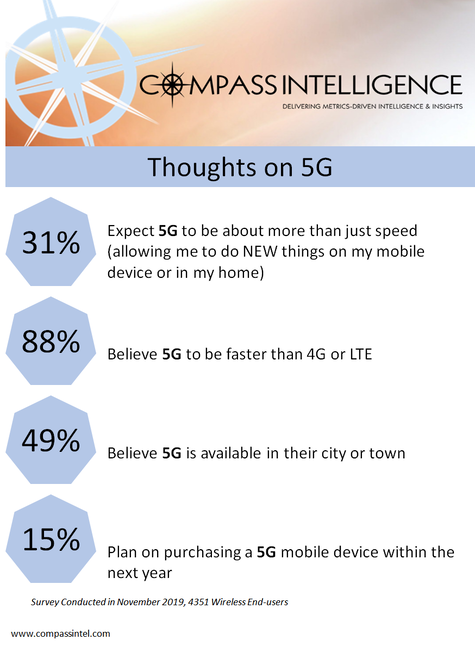|
U.S. wireless carriers have made significant strides in rolling out 5G services across major cities, but all are on different paces using varying spectrum strategies to reach both consumers and business end-users. According to a recent article on SDxCentral, "Earlier this month, T-Mobile US leapfrogged all of its competitors with a nationwide 5G network running on 600 MHz spectrum. The operator’s low-band 5G network covers about 200 million people, or about 61% of the total population, spanning a geographic range of more than 1 million square miles." They also share that AT&T will reach part of 30 cities by early 2020 with AT&T confusing some in the industry by using the term “5G E” brand in select cities, while using “5G” brand for 5G running over low-band spectrum, and “5G+” for those running on mmWave spectrum. Verizon recently announced reaching 30 cities and 14 NFL stadiums by the end of this year. Lastly, Sprint started out 2019 with a strong leading roll-out of 5G but is expected to end the year covering roughly 11 million people. Also, U.S. Cellular shares it will launch 5G service in Q1 of 2020.
Meanwhile, a recent survey conducted by Compass Intelligence shows roughly 49% of those 4K+ wireless end-users surveyed across the U.S. believe 5G is available within their city or town, with 15% planning on purchasing a 5G enabled smartphones or devices in 2020. As consumers plan upgrades, phone replacements, and trade-ins on their smartphones, it only makes sense to make sure your device is 5G ready or enabled. Most wireless end-users, 88% of the 4,351 surveyed, believe 5G will be faster than 4G or LTE, with 31% believing 5G will be much more than just a faster or speed upgrade when compared to 4G or LTE services. Wireless carriers have not really been effective at communicating what these other advantages are to consumers at this stage, as most of the marketing and communication has been about the coming advantages to business solutions yet consumers will see brand new customer experiences with 5G like they have not seen in the past. As for now, experiences within venues like airports, stadiums and event venues, shopping/retail, and engaging within a city has the potential to offer brand new real-time and personalized experiences. Many ideas have been shared at a high-level, but think about seamless buying and shopping catered to your needs and wants with better location, routing, checkout, and service. Within a city, interacting with public transportation or city services may be enhanced as 5G brings speeds that better leverage video, virtual reality (think 3D virtual city tours or interactive Uber ride experiences), and immersive experiences. Stay tuned next week to the latest in plans to switch carriers ...survey research rocks! Comments are closed.
|
Inside MobileCovering hot topics in the industry, new research, trends, and event coverage. Categories
All
|


 RSS Feed
RSS Feed
